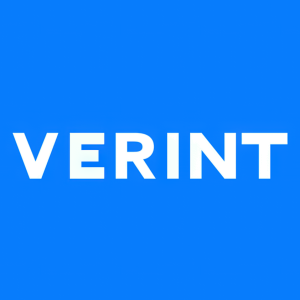Verint to Hold Investor Day Today at 10:30 a.m. ET
Focus on CX Automation Category Leadership and AI Monetization Strategy
Showcase Customers Reporting Significant AI Business Outcomes
Discuss Simplification of Business and Introduce Subscription ARR and Cash Generation Metrics
Provide FYE 2026 Outlook for ARR and Free Cash Flow Growth
“We are delighted to be hosting our investor day today, where we will discuss the CX market evolution, Verint’s CX Automation category leadership and Verint’s AI monetization strategy. In addition to hearing from Verint’s management, Verint customers will discuss the significant AI business outcomes they are achieving with the Verint CX platform. The presentations will be followed by a Q&A session, and we look forward to speaking with you later today,” said Verint CEO Dan Bodner.
CX Market Evolution
The primary challenge for brands in their CX initiatives is the unsustainable cost of labor. Today, brands are using many workflows in their efforts to delight customers with superior customer experience. Because these CX workflows are mostly manual, any time brands want to improve CX, they are required to increase what is already a large and expensive CX workforce.
The recent advances in AI-powered automation make it possible to fully or partially automate CX workflows. Because the economic benefits for brands are so significant, CX Automation is now an important solution category in the CX market and an integral part of the enterprise technology ecosystem.
CX Automation Category Leadership
Our platform currently offers more than 50 different AI-powered bots. Each bot is uniquely designed to fully or partially automate specific steps of a manual CX workflow. We invented a differentiated approach to CX Automation based on automating these micro-workflows with bots that are uniquely designed for each specific task. As a result, each of the Verint bots automates a specific micro-workflow and does it very well. Due to the high precision of the bots, we are able to drive the desired AI business outcome for customers. This best-of-breed approach to AI-powered bots is resonating well with our customers.
Today, our platform is highly differentiated in its ability to deliver stronger AI business outcomes than any other CX vendor, and its ability to deliver into a customer’s existing ecosystem, without disrupting their operations.
AI Monetization Strategy
Our AI monetization strategy is based on our customers’ preference to start with a low level of automation consumption and increase automation over time, as they see business outcomes. This drives incremental consumption and revenue growth over time for Verint. Our open platform architecture, specifically our hybrid cloud approach, is a tremendous accelerator for customer adoption and enables us to deliver outcomes faster than any competitive offering.
Introducing Subscription ARR (ARR) and Cash Generation Metrics
We have completed our transition to a subscription model with approximately
We believe that ARR is a useful metric for investors, since it represents the true growth of our subscription business, avoiding any variability associated with ASC 606 revenue accounting. Due to this volatility, we will also begin to report cash contribution margin and operating efficiency metrics annually.
Verint Chief Financial Officer, Grant Highlander, added, “We are pleased that our business has been greatly simplified with a subscription model. Looking forward, we are optimistic about our AI monetization strategy, which gives customers the ability to adopt AI without disruption and increase usage over time, as they see value. We expect demand for our CX Automation solutions to accelerate the growth of our subscription business. For fiscal 26, we are targeting our ARR growth to improve to
FYE 2025 and FYE 2026 ARR Outlook
Our ARR outlook is as follows:
-
For Q4 January 31, 2025:
$704 Million 4% year-over-year growth (adjusted for prior year divesture) -
For Q4 January 31, 2026:
$760 million 8% year-over-year growth
Please see our Investor Dashboard on our website for historical ARR Data.
FYE 2025 Revenue and Diluted EPS Outlook
Our revenue and non-GAAP diluted EPS outlook for the year ending January 31, 2025 is as follows:
-
Revenue:
$933 million 2% , reflecting5% year-over-year growth (adjusted for the divestiture) -
Diluted EPS:
$2.90 6% year-over-year growth.
Our non-GAAP outlook for year ending January 31, 2025 excludes the following GAAP measure which we are able to quantify with reasonable certainty:
-
Amortization of intangible assets of approximately
$20 million
Our non-GAAP outlook for the year ending January 31, 2025 excludes the following GAAP measures for which we are able to provide a range of probable significance:
-
Stock-based compensation expenses are expected to be between approximately
$76 million $78 million
Our non-GAAP guidance does not include the potential impact of any in-process business acquisitions that may close after the date hereof, and, unless otherwise specified, reflects foreign currency exchange rates approximately consistent with current rates.
We are unable, without unreasonable efforts, to provide a reconciliation for other GAAP measures which are excluded from our non-GAAP outlook, including the impact of future business acquisitions or acquisition expenses, future restructuring expenses, and non-GAAP income tax adjustments due to the level of unpredictability and uncertainty associated with these items. For these same reasons, we are unable to assess the probable significance of these excluded items.
Investor Day Conference Call Information
Date: January 14, 2025
Time: 10:30am ET – 12:30pm ET
Location: Virtual
Registration: Click here to receive your dial-in number and unique PIN to access the event. The live event may be accessed on Verint’s Investor Relations webcast page.
About Verint Systems Inc.
Verint® (Nasdaq: VRNT) is a leader in customer experience ("CX") automation. The world’s most iconic brands – including more than 80 of the Fortune 100 companies – use the Verint Open Platform and our team of AI-powered bots to deliver tangible AI business outcomes across the enterprise.
Verint. The CX Automation Company™, is proud to be Certified™ by Great Place To Work®. Learn more at Verint.com.
Cautions About Forward-Looking Statements
This press release contains forward-looking statements, including statements regarding expectations, predictions, views, opportunities, plans, strategies, beliefs, and statements of similar effect relating to Verint Systems Inc. These forward-looking statements are not guarantees of future performance and they are based on management's expectations that involve a number of known and unknown risks, uncertainties, assumptions, and other important factors, any of which could cause our actual results or conditions to differ materially from those expressed in or implied by the forward-looking statements. Some of the factors that could cause our actual results or conditions to differ materially from current expectations include, among others: uncertainties regarding the impact of changes in macroeconomic and/or global conditions, including as a result of slowdowns, recessions, economic instability, elevated interest rates, tightening credit markets, inflation, instability in the banking sector, actual or threatened trade wars, political unrest, armed conflicts, natural disasters, or outbreaks of disease (including global epidemics or pandemics), as well as the resulting impact on spending by customers or partners, on our business; risks that our customers or partners delay, downsize, cancel, or refrain from placing orders or renewing subscriptions or contracts, or are unable to honor contractual commitments or payment obligations due to challenges or uncertainties in their budgets, liquidity, or businesses; risks associated with our ability to keep pace with technological advances and challenges and evolving industry standards, including achieving, demonstrating, and maintaining the competitive differentiation of our solution platform; to adapt to changing market potential from area to area within our markets; and to successfully develop, launch, and drive demand for new, innovative, high-quality products and services that meet or exceed customer challenges and needs, while simultaneously preserving our legacy businesses and migrating away from areas of commoditization; risks due to aggressive competition in all of our markets and our ability to keep pace with competitors, some of whom may be able to grow faster than us or have greater resources than us, including in areas such as sales and marketing, branding, technological innovation and development, and recruiting and retention; risks associated with our ability to properly execute on our software as a service ("SaaS") transition, including successfully transitioning customers to our cloud platform and the increased importance of subscription renewal rates and term lengths, and risk of increased variability in our period-to-period results based on the mix, terms, and timing of our transactions; risks relating to our ability to properly identify and execute on growth or strategic initiatives, manage investments in our business and operations, and enhance our existing operations and infrastructure, including the proper prioritization and allocation of limited financial and other resources; risks associated with our ability to or costs to retain, recruit, and train qualified personnel and management in regions in which we operate either physically or remotely, including in new markets and growth areas we may enter, due to competition for talent, increased labor costs, applicable regulatory requirements, or otherwise; challenges associated with selling sophisticated solutions and cloud-based solutions, which may incorporate newer technologies, such as artificial intelligence ("AI"), whose adoption, value, and use-cases are still emerging (and may present risks of their own), including with respect to longer sales cycles, more complex sales processes and customer evaluation and approval processes, more complex contractual and information security requirements, and assisting customers in understanding and realizing the benefits of our solutions and technologies (including versus those of our competitors), as well as with developing, offering, implementing, and maintaining an enterprise-class, broad solution portfolio; risks that we may be unable to maintain, expand, or enable our relationships with partners as part of our growth strategy, including partners with whom we may overlap or compete, while avoiding excessive concentration with one or more partners; risks associated with our reliance on third-party suppliers, partners, or original equipment manufacturers (“OEMs”) for certain services, products, or components, including companies that may compete with us or work with our competitors; risks associated with our significant international operations, including exposure to regions subject to political or economic instability, fluctuations in foreign exchange rates, inflation, increased financial accounting and reporting burdens and complexities, and challenges associated with a significant portion of our cash being held overseas; risks associated with a significant part of our business coming from government contracts, and associated procurement processes and regulatory requirements; risks associated with our ability to identify suitable targets for acquisition or investment or successfully compete for, consummate, and implement mergers and acquisitions, including risks associated with valuations, legacy liabilities, reputational considerations, capital constraints, costs and expenses, maintaining profitability levels, expansion into new areas, management distraction, post-acquisition integration activities, and potential asset impairments; risks associated with complex and changing domestic and foreign regulatory environments, including, among others, with respect to data privacy, AI, cyber/information security, government contracts, anti-corruption, trade compliance, climate change or other environmental, social and governance matters, tax, and labor matters, relating to our own operations, the products and services we offer, and/or the use of our solutions by our customers; risks associated with the mishandling or perceived mishandling of sensitive or confidential information and data, including personally identifiable information or other information that may belong to our customers or other third parties, including in connection with our SaaS or other hosted or managed services offerings or when we are asked to perform service or support; risks associated with our reliance on third parties to provide certain cloud hosting or other cloud-based services to us or our customers, including the risk of service disruptions, data breaches, or data loss or corruption; risks that our solutions or services, or those of third-party suppliers, partners, or OEMs which we use in or with our offerings or otherwise rely on, including third-party hosting platforms, may contain defects, vulnerabilities, or develop operational problems; risk that we or our solutions may be subject to security vulnerabilities or lapses, including cyber-attacks, information technology system breaches, failures, or disruptions; risks that our intellectual property ("IP") rights may not be adequate to protect our business or assets or that others may make claims on our IP, claim infringement on their IP rights, or claim a violation of their license rights, including relative to free or open source components we may use; risks associated with leverage resulting from our current debt position or our ability to incur additional debt, including with respect to liquidity considerations, covenant limitations and compliance, fluctuations in interest rates, dilution considerations (with respect to our convertible notes), and our ability to maintain our credit ratings; risks that we may experience liquidity or working capital issues and related risks that financing sources may be unavailable to us on reasonable terms or at all; risks arising as a result of contingent or other obligations or liabilities assumed in our acquisition of our former parent company, Comverse Technology, Inc. (“CTI”), or associated with formerly being consolidated with, and part of a consolidated tax group with, CTI; risks associated with changing accounting principles or standards, tax laws and regulations, tax rates, and the continuing availability of expected tax benefits; risks relating to the adequacy of our existing infrastructure, systems, processes, policies, procedures, internal controls, and personnel, and our ability to successfully implement and maintain enhancements to the foregoing, for our current and future operations and reporting needs, including related risks of financial statement omissions, misstatements, restatements, or filing delays; risks associated with market volatility in the prices of our common stock and convertible notes based on our performance, third-party publications or speculation, or other factors, and risks associated with actions of activist stockholders; risks associated with Apax Partners' significant ownership position and potential that its interests will not be aligned with those of our common stockholders; and risks associated with the February 1, 2021 spin-off of our former Cyber Intelligence Solutions business, including the possibility that the spin-off transaction does not achieve the benefits anticipated, does not qualify as a tax-free transaction, or exposes us to unexpected claims or liabilities. We assume no obligation to revise or update any forward-looking statement, except as otherwise required by law. For a detailed discussion of these risk factors, see our Annual Report on Form 10-K for the fiscal year ended January 31, 2024, our Quarterly Report on Form 10-Q for the quarter ended April 30, 2024, our Quarterly Report on Form 10-Q for the quarter ended July 31, 2024, our Quarterly Report on Form 10-Q for the quarter ended October 31, 2024, and other filings we make with the SEC.
VERINT, VERINT DA VINCI, VERINT OPEN CCAAS, THE CX AUTOMATION COMPANY, THE CUSTOMER ENGAGEMENT COMPANY, and THE ENGAGEMENT CAPACITY GAP are trademarks of Verint Systems Inc. or its subsidiaries. Verint and other parties may also have trademark rights in other terms used herein.
Revenue Metrics and Operating Metrics
SaaS Annual Contract Value (ACV) (formerly known as New SaaS ACV) includes the annualized contract value of all new SaaS contracts received within the period; new unbundled SaaS contracts only include the license portion of those orders. In cases where SaaS is offered to partners through usage-based contracts, we include the incremental value of usage contracts over a rolling four quarters. Orders are only included in SaaS ACV with a completed customer contract signed by both parties before the end of the period. Unbundled SaaS ACV includes only the ACV of the unbundled SaaS contracts included in SaaS ACV. Bundled SaaS ACV includes only the ACV of the bundled SaaS contracts included in SaaS ACV and is comprised of two components:
New Deals ACV, which represents the annual contract value of new bundled SaaS contracts, received within the period. This includes purchases of new applications by both new and existing customers as well as expansions of entitlements to applications already in use by existing customers, other than if in connection with a conversion. AI booking from new deals represents the portion of New Deals ACV attributable specifically to AI applications.
Conversion ACV, which represents the bundled SaaS annual contract value sold to a customer who is converting from an on-premises application to the Verint Cloud within the period. This metric also includes the value of incremental licenses or expansion of entitlements as part of the conversion, including for AI applications.
Subscription Annual Recurring Revenue (ARR) represents the annualized quarterly run-rate of our active subscription agreements at the end of the period and is comprised of the ARR calculated for our SaaS, Support, and Optional Managed Services contracts. Under ASC Topic 606, Revenue from Contracts with Customers, we are required to recognize a significant portion of our Unbundled SaaS contracts at a point in time when the software is first made available to the customer, or at the beginning of the subscription term, despite the fact that our contracts typically call for billing these amounts annually or more frequently over the life of the subscription. This point-in-time recognition of a portion of our recurring revenue creates significant variability in the revenue recognized period to period based on the timing of the subscription start date and the subscription term and can create a significant difference between the timing of our revenue recognition and the actual customer billing under the contract. We use ARR to measure the underlying performance of our subscription-based contracts and mitigate the impact of this variability as ARR reduces fluctuations due to seasonality, contract term, and the sales mix of subscriptions. ARR should be viewed independently of revenue, and does not represent our revenue under ASC 606 on an annualized basis, as it is an operating metric that is impacted by contract start and end dates and renewal rates. ARR is not intended to be a replacement for forecasts of revenue and does not include revenue reported as nonrecurring revenue in our consolidated statement of operations.
SaaS Annual Recurring Revenue (SaaS ARR) represents the annualized quarterly run-rate value of active or signed SaaS contracts as of the end of a period. For unbundled SaaS contracts, the amount included in SaaS ARR is generally consistent with the amount that we invoice the customer annually for the term-based license transaction. In the case of acquired contracts that allow for early termination, SaaS ARR will reflect the annualized amount of committed contracts in the first quarter and then proportionally increase to the remaining amount of annualized ARR in the subsequent three quarters during the first year post acquisition. We use SaaS ARR to identify the annual recurring value of customer contracts at the end of a reporting period and to monitor the growth of our recurring business as we shift to SaaS. SaaS ARR reduces fluctuations due to seasonality, contract term, and the sales mix of subscriptions for bundled SaaS and unbundled SaaS. SaaS ARR should be viewed independently of revenue, and does not represent our revenue under ASC 606 on an annualized basis, as it is an operating metric that is impacted by contract start and end dates and renewal rates. SaaS ARR is not intended to be a replacement for forecasts of SaaS revenue.
Cash Generation represents the sum of ARR and perpetual and professional services and other revenue and provides an estimate of the cash-producing potential of our entire business.
Cash Contribution Margin is defined as Cash Generation less cost of revenue and operating expenses and helps assess how effectively we convert our revenue streams into cash.
Operating Efficiency Percentage is the result of dividing Cash Contribution Margin by Cash Generation and helps assess the rate at which we convert our revenue streams into cash.
Free Cash Flow is defined as GAAP cash provided by operating activities less our capital expenditures, which include purchases of property and equipment and capitalized software development costs.
View source version on businesswire.com: https://www.businesswire.com/news/home/20250114163841/en/
Investor Relations
Matthew Frankel, CFA
Verint Systems Inc.
(631) 962-9600
matthew.frankel@verint.com
Source: Verint Systems Inc.









